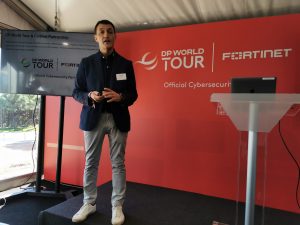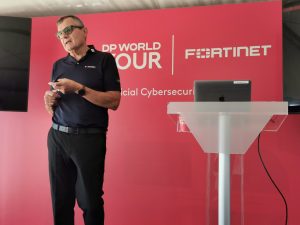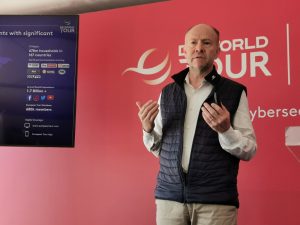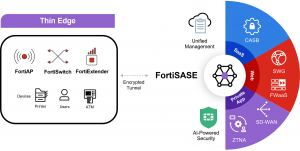FortiSASE, at the Heart of the DP World Golf Tour

We learn how Fortinet’s technology has helped redefine the way professional golf is experienced and managed on a global scale.
Last weekend, the Acciona Open de España de Golf, a DP World Tour tournament, was held in Madrid and Silicon was there to see first-hand the cybersecurity deployment that protects the vast amount of data generated from multiple sources and makes it continuously available, even in real time.
This is thanks to Fortinet’s technology, which goes beyond the figure of the traditional sponsor by providing its solutions and working with the technical team of the circuit to achieve this in each of the 47 tournaments that make up this worldwide tour.
Acacio Martín, vice president of sales at Fortinet Iberia, confirmed that they are not only tournament sponsors, but also official providers of all cybersecurity, including data and statistics on players, attendees, logistics, ball trajectories, course and weather conditions, as well as everything related to television broadcasts, as we will see later on.

To understand the complexity of this type of deployments, we chatted with Alain Sanchez, EMEA Field CISO at Fortinet, who did not hesitate to emphasise the important evolution that has taken place in such a traditional sport as golf: ‘Only 7 years ago, if an assistant found a spectator using his mobile phone, he would give him a penalty. If this happened three times, the person would be sent off the course. It’s unthinkable today because without our mobile devices we miss so much of what’s going on in the tournament, the user experience is greatly reduced.‘
Certainly, spectators have access to all that information that is generated from multiple sources, not only those who are in the facilities, but the viewers, who can reach up to 10 million in certain tournaments according to the organisation’s figures. ‘From the time a player touches the ball to the time he stops in the middle of each hole, 15 different data parameters are generated. That and a lot of other data is being sent in real time to the organisation’s data lake… and it has to be secured, as well as the applications and the connections of the thousands of fans that are on the golf course facilities. That’s one of the main functions of our technology, that everything is in a secure environment from start to finish,’ said Sánchez.

Meanwhile, Michael Cole, CTO of the DP World Tour (with whom we also had the opportunity to meet in 2018 for the Ryder Cup in Paris), gave details of the complexity that goes into each tournament over the four days: ‘We deploy four different infrastructures for each tournament: one for the Wi-Fi, one for the TV cameras, one for the scoring system and one for the internal TV circuit, which is made up of different sized screens around the course so viewers don’t miss a thing.‘
Cole also referred to the 15 parameters mentioned by Sánchez that are collected for each shot: from the club and swing selected by the player to the power of the shot, the speed of the ball and the exact coordinates of where it stops.
The balls are the property of each player and do not have any sensors, so here the figure of the data collectors (people from the organisation with a tablet where they manually write down each of these data and a backpack to send them to the server) is of great importance.
Cole also emphasised the change that has taken place over the last few years with the use of technology in the field and the need to secure every bit that is sent or received: ‘Until a few years ago, the use of mobile devices was forbidden, but now we have adopted a “mobile first” approach, so we encourage all attendees to consume all the content we generate.‘

But this has also created major security challenges. For example, the ‘mobile first’ approach that Cole talks about has also been taken to the operations and logistics of each tournament, such as the organisation of the players throughout each day or the communication between the different teams that make up the organisation of the circuit.
In the end, all the data is flowing through internal communications (the Wi-Fi infrastructure discussed above), external telecommunications networks and the data lake where the information is stored. And this is where Fortinet’s technology comes into play.
FortiSASE, a holistic view of security
Sánchez offered a simile that perfectly illustrates what a golf Tour of this magnitude entails on a technological level: ‘these facilities are like a small city that is connected for four days, but when each tournament is over, they move to another place, hundreds or maybe thousands of kilometres away where the next one is being held’. It’s something that must be done in record time and depending on the infrastructure that each of these 47 tournaments has: ‘Each tournament venue is unique and offers varying levels of quality, so quickly adapting the security and availability strategy is crucial to support Tour operations,’ said Fortinet’s CISO.
In practice, SASE (Secure Access Service Edge) architectures, and specifically FortiSASE, are what enable such highly secure deployments from the cloud (where the data lakes are located) to the network perimeter (where each tournament venue is located). This holistic vision allows everything to be virtualised as if it were in the same environment, but allowing a high degree of versatility and adaptability to the technical conditions of each location.
‘What differentiates FortiSASE from other alternatives,’ Sanchez continued, ’is that it is not built with a layered architecture, but directly on top of the FortiOS operating system. All the security components, such as firewall, identity control, antivirus, segmentation, VPN control, routing, Wi-Fi connections and others, converge in the operating system, which makes it easier to control and deploy services in a unified way.

Cole himself explained what working with Fortinet has meant: ‘FortiSASE plays a key role in supporting our digital transformation by providing secure and consistent access to all of our applications and services for our remote and mobile workforce as they continue to operate around the world.‘
In short, this collaboration between Fortinet and the DP World Tour enables the integrity and availability of the circuit’s data and systems to be protected, as well as enabling seamless and secure access to applications and services for all stakeholders, regardless of their location, device or even the network itself.
Operationally, it improves visibility and control of the network, applications and endpoints through advanced threat intelligence and analytics, while streamlining management and orchestration through a single pane of glass.
A clear example of how technology can be integrated into the traditional sport of golf to enhance security and the fan experience.